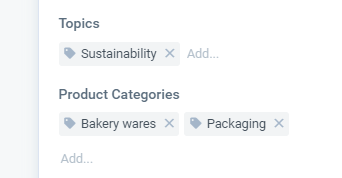Understanding Post Topics
How Digicomply classifies content to help you filter regulatory noise.
What are Topics?
Topics are classifications assigned to each post by SGS Digicomply experts to help you find relevant regulatory content more easily. Each post can have multiple topics assigned to it based on its content.
How to Use Topics
You can filter posts by one or more topics simultaneously in feeds and searches. When a post has multiple topics assigned (for example, both "Policies and Laws" and "Labelling"), it will appear in your results when you filter for any of those topics.
Topics appear on the right side of each post in the system, helping you quickly understand the content focus.
Example: A post about new labelling requirements for organic products might be classified under "Labelling", "Additives, nutrition and organic food", and "Policies and Laws". Filtering for any of these three topics will show you this post.


Available Topics
|
Topic |
Description |
|
Alerts and recalls |
Official alert system for non-compliant food or feed products and recalls when relevant |
|
Policies and Laws |
Any content related to the legislative process, from news that could lead to future regulations, to consultations and drafts, up to actual regulations |
|
Standards |
Any type of standards, either national or international, including text of standards, news related to creation/update/deprecation of standards, and Commodity Standards/Standards of Identity |
|
Animals & Animal Feed |
Posts relevant to animals (livestock and pets) and feed industry, including ingredients, animal by-products, additives, feed hygiene, marketing, contaminants, veterinary drugs, animal welfare, diseases, breeding, identification and traceability |
|
Contaminants, residues and contact materials |
All types of contaminants and residues in foods and feeds (mycotoxins, chemical contaminants, pesticides, veterinary drugs, undesirable substances, etc.), excluding microbiological criteria. Also includes contamination from food contact materials, inner packaging requirements, and manufacturing standards |
|
Additives, nutrition and organic food |
Content related to food additives, enzymes and processing aids, flavourings, nutrition science, health-related matters, and organic products |
|
Food Safety and Security |
Food safety matters and risk assessment, including quality control processes and procedures, hygiene and microbiological criteria, food security, food wastes, and Life Cycle Assessment (LCA) |
|
Labelling |
Information to be displayed on primary and secondary packaging (List of Ingredients, allergens, GMO labelling, organic labelling, nutrition facts labelling, ethical labelling - fair trade, vegetarian, etc.) |
|
Trade, market and official controls |
Import and export rules (trade policies, agreements, taxes, TNT and SPS, etc.) for all food and feed articles, live animals, seeds and plants, and official controls and inspections from local authorities. Also includes market intelligence reports, distant selling, and trade statistics |
|
Methods and Manufacturing |
Content relevant to manufacturing plants, testing methods (to detect residues, microbiological contamination, nutritional composition, etc.) and new technologies (GMOs, nanotechnologies, novel food, etc.) |
|
Sustainability |
Environment-related content including waste, pollution, recycling, energy efficiency, water, climate impact, and welfare. In food context, this frequently means packaging |
|
Other |
Content that doesn't fit into the above categories |